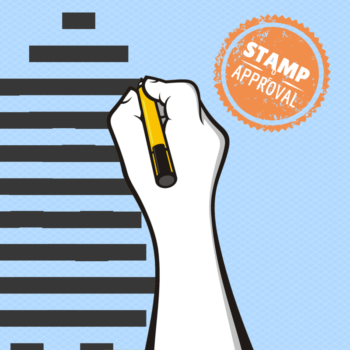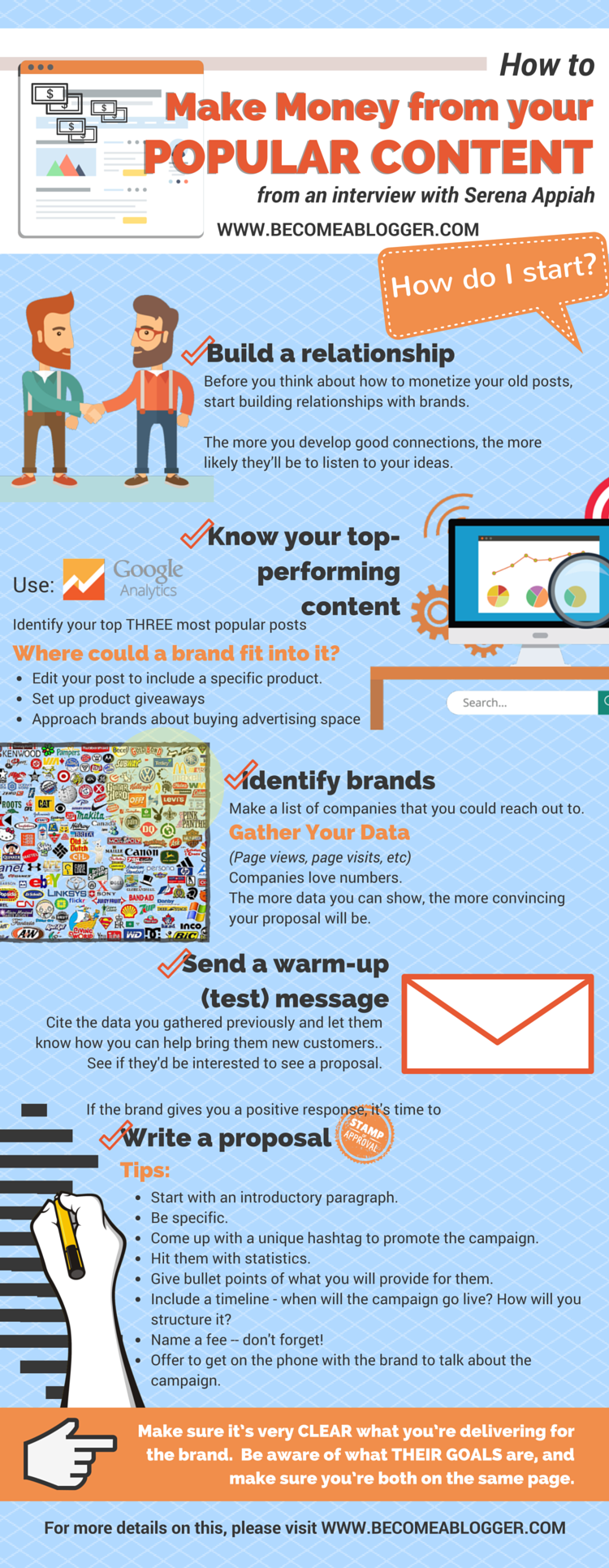Who: Serena Appiah
Blog: Thrift Diving
Want to re-amplify some of your most popular content?
Looking for new ways to make money with your blog?
Listen to This Episode
In this episode, Serena Appiah tells you how to monetize your popular posts and build relationships with brands.
This part two of my latest interview with Serena. You can check out part one, How to Make Money with Sponsored Content, in Episode 260.
Who is Serena Appiah?


Serena left her job in January 2015 to blog full time at Thriftdiving.com, where she shows you how to decorate, improve, and maintain your home on a DIY budget.
If you want to know more about Serena’s story, head on over to Episode 260. For now, let’s jump right into today’s topic: how to make money from your popular content.
The Idea
Serena came up with an interesting and creative idea to get new income from old content through a discussion with her Mastermind group.
She noticed that her top-performing posts weren’t her most recent posts. Her most popular post, where she re-painted an old china cabinet, was from all the way back in 2013!
In that post, Serena used a particular brand of paint, RECLAIM Beyond Paint. The post from 2013 wasn’t sponsored, but Serena has built a relationship with this brand since then. So she thought they might be able to help her re-amplify this popular post that featured their product.
Why would a brand care about something you posted three years ago? Brand awareness.
If you can show them that you’ve got some high-performing content, it doesn’t matter how old the post is. It can’t fail. You’ve already proven that the content is popular. They know that people are going to see it, and that’s great news for a brand in terms of getting their products out there.
Where Do I Start?
Serena walked me through the key steps to making money with your popular content.
Step 1: Build a relationship


Relationships are as important as your content in the blogging business. So before you think about how to monetize your old posts, start building relationships with brands.
Serena talks a lot about how to build these relationships in Episode 260.
The more you can develop a good connection with a brand, the more likely they’ll be to listen to your ideas.
Step 2: Know your top-performing content
If you’re going to pitch to a brand, you need to know what your top-performing posts are. That’s easy to do with Google Analytics.
Once you log in, look under Behavior, then Site Content, then All Pages. Look at the last three years or so (depending on how long you’ve been blogging).


You should identify your three most popular posts. Then, really look at them. Where could a brand fit into it?
Serena was lucky: her most popular post already featured a product, so it was pretty clear how the brand could benefit. But even if you aren’t featuring a particular product or service, you can get creative about how to incorporate a brand into your post.
One strategy is to edit a post so to include a specific product. For example, one of my most popular posts (which I didn’t even write!) talks about making vlogs with your smartphone. It doesn’t mention any products right now, but it would be pretty easy to change to include some useful products for smartphone vloggers.
You can also set up product giveaways, which are great because they drive traffic straight to the brand, as well as increasing traffic for you.
Another option is to approach brands about buying advertising space on that post.
Use your imagination! Give the brand an idea they might not have thought about before.
Step 3: Identify brands


After looking carefully at your top-performing posts, make a list of companies that you could reach out to.
This step is also about gathering your data. Companies love numbers, so jot down all the details from your Google Analytics. How many page views does your top post have in total? Per month? Per year? The more data you can show them, the more convincing your proposal will be.
Step 4: Send a warm-up message
Once you know which companies to approach, send a test message to see if they’re interested. This is especially important if you don’t already have a relationship with the brand.


In your message, tell the brand that you have a great idea to promote their product and bring them some new customers. Say that you have high-performing content, and tell them how many page views it gets per month. Ask them if they’d be interested in seeing a proposal.
Step 5: Write a proposal
If the brand gives you a positive response, it’s time to write the proposal. It should be a Word document that’s 2 to 4 pages long.
Here’s are Serena’s proposal-writing tips:
- Start with an introductory paragraph. This should tell the brand why you think your readers needs this post and why your idea would make a good campaign.
- Be specific. Just like pitching sponsored posts, you need to give the brand lots and lots of detail. They need to know exactly what they can expect from you.
- Come up with a unique hashtag to promote the campaign. It’s got to be something that will really catch their attention. You can then track this hashtag using hashtracking.com.
- Hit them with statistics. How many page views is your post getting? How many social shares? Prove to them that this is a high-performing post.


Give bullet points of what you will provide for them. When she pitched her campaign for RECLAIM Beyond Paint, Serena told the brand that she would:
- Republish the old, popular post to her blog. This means changing the date so that it moves up chronologically and is visible as a recent post.
By the way, when you republish a post, it keeps its social shares, so people will see that it’s already popular. That social proof is really helpful! - Resend the post to her email subscribers (Serena has just under 6,000 subscribers).
As time goes on, your blog gets more subscribers. Many of your newer subscribers may never have seen your older content, so it’s great to show them an old but popular post in this way. - Include two direct links of their choice in the email. One of these will be a link to the content on your blog, but the other could be to their website or one of their social media pages, for example.
- Post it on Facebook, and boost the post to people who follow her page. Serena says that boosting a post on Facebook is definitely worth the $10-15 cost.
- Schedule repins to 15 group boards on Pinterest.
- Bring on five additional bloggers to post about the campaign on Facebook and pin it to their boards on Pinterest.
We’ll talk more about these bloggers in a second. - Provide a final report. Serena says that her reports are sometimes ten pages long, and include things like screenshots and copies of comments. It helps the brand feel they got their money’s worth. It’s also useful for you to know how successful the campaign was.
Managing the Campaign


You landed a campaign. Great! Now what about those other bloggers you promised?
Serena says it’s a good idea to put the word out before you’ve got everything locked in with the brand. Some of her bloggers were her friends, but others she found just by putting out a call on social media. She used a Google form to find out more about her potential influencers.
On the form, she just asked for their name, email address, website URL, social media links, and PayPal address. She also asked whether they were happy with the proposed fee ($200 in this case).
When vetting the applicants, Serena was interested in the number of Facebook followers they had and their level of engagement. The threshold for followers was 15,000. However, Serena says she used a blogger with a lower number of followers but very high engagement.
Once you’ve selected your influencers, send them a document with instructions. This should include the guidelines for their post, how much you’ll pay them and when, instructions for submitting links to you, and your contact details.
Be really clear about what you expect from their social media posts. Make sure they use the campaign hashtag. They should also include #ad so that viewers know they’re looking at sponsored content (this is a requirement across social media!).
Results


For her RECLAIM campaign, Serena used a bitly link to track how many clicks the brand received. By the end of the campaign, the link had attracted 23,000 clicks to the brand’s page.
In the month of the campaign, Serena’s post went from 43,000 views per month to 86,000 views per month. It doubled in popularity. Her ad revenue had more than doubled, too. Incredible!
Final Tip
Serena says to make sure it’s very clear what you’re delivering for the brand. You don’t want to end up in a situation where they’re expecting increased sales but you think you’re delivering exposure.
Be aware of what their goals are, and make sure you’re both on the same page.
Resources Mentioned
- How to Make Money with Sponsored Content – linked to the first part of this interview with Serena Appiah
- How to Paint a Dresser in 10 Easy Steps! – Serena's most popular post that she used to feature a brand
- hashtracking.com – helps track hashtags especially those used in campaigns
- Thrift Diving – Serena's blog
Infographic


